There are many rites of passage for Magic players. Those could be anything from knowing when to mulligan, to recognizing who’s the beatdown. One of those rites of passage, however, is easily forgotten: overpacking for your first MagicFest. Like many other players, I brought too much stuff with me for my first major event. I took the foam insert out of my Pirate Lab card case, and lugged around a large rectangular shoulder bag, filled with decks and things I never used. I ended that weekend with some cool prizes and a dreadfully sore back.
When large Magic events come back, I want to prepare for them differently. Instead of bringing several decks in individual boxes, I’ve created a modular system to fit more decks in less space. This allows me to be prepared for more games with friends, without having to carry extraneous weight. As it stands now, I can fit ten decks in the space you’d need for six or seven. Here’s how I got there.
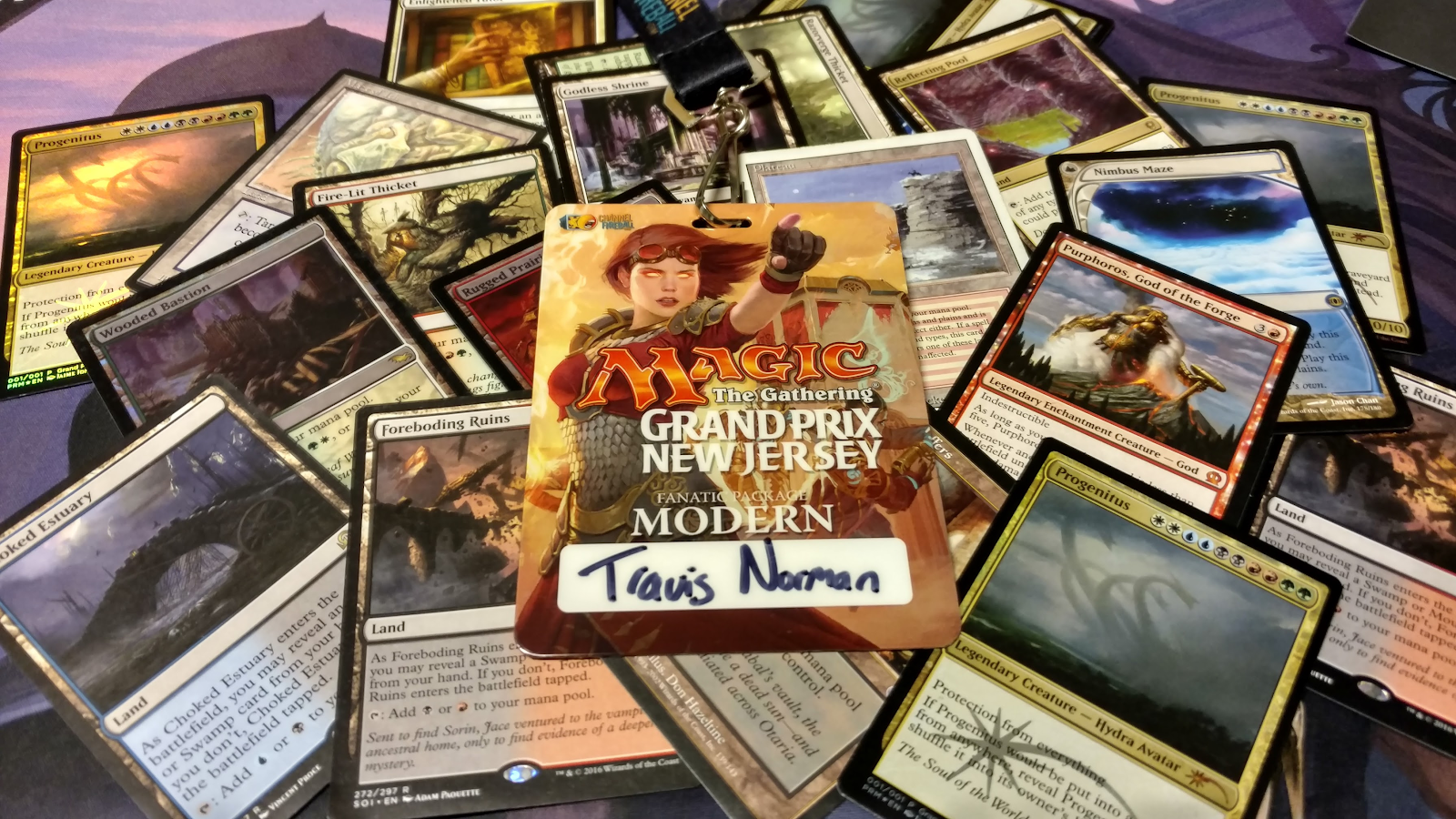
The Case
After researching a variety of cases for the job, I landed on the flagship model from Quiver. It offers a blend of features that I’m looking for, namely the zippered closure and the shoulder strap. Carrying capacity is solid, with it fitting up to 630 double-sleeved cards. While it can go up to 800 single-sleeved cards, I’ve learned from experience that single-sleeving at a big event is asking for trouble. You don’t need to be in a convention hall for long, before you hear a horror story of someone spilling one of those root beers sold in Moscow Mule mugs.
The Quiver case is low-profile, allowing easy passage through crowded spaces. Also, it can easily sit in your lap when you’re out grabbing lunch. Easy to carry around, easy to keep an eye on.
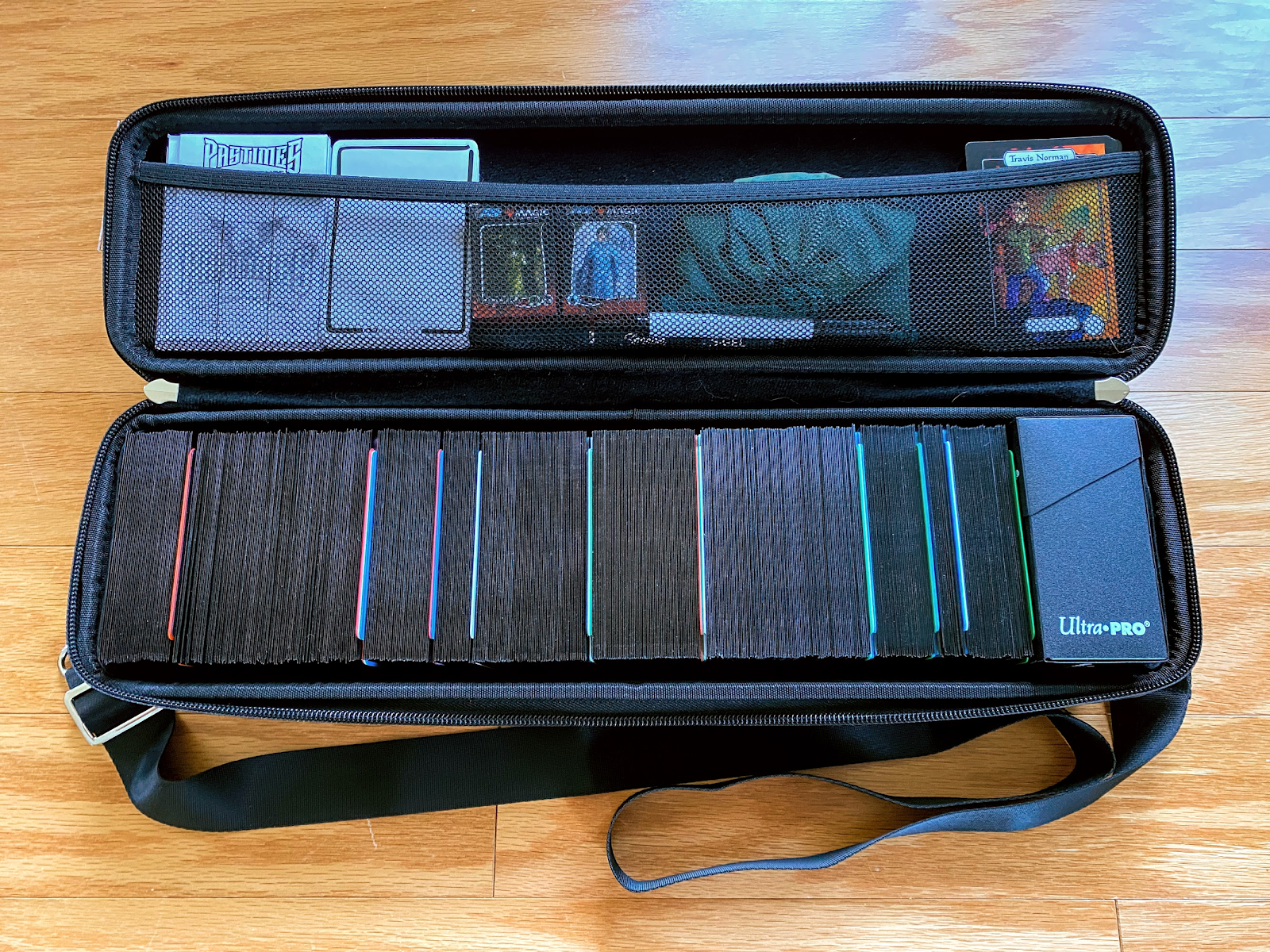
Design Philosophy
When designing my modular case, I followed a few rules:
1. All cards must have identical sleeves.
This allows me to easily swap things in and out, and not spend time re-sleeving. I love having sleeves match the flavor of the deck, but in order for this to work, they all had to be the same color. In the interest of uniformity, I went with “Ol Reliable”, DragonShield Matte Black.
2. All decks have to share the same basic lands.
While it can be a flavor win to have the perfect Shards of Alara basics for Gahiji, my other decks aren’t going to like foil depictions of Naya. Since I only run old border basics in my Premodern decks, I picked from ‘95-’03 basics for my case. It ended with this assortment of my favorite basic lands in the game.

To determine how many of each basic land I’d need, I scrolled through all of my decklists and made note of each deck that posted the highest quantity. That provided the framework for my basic land needs, without carrying any that I didn’t need. However, I do have a few decks that have lands that are proxied, such as my Bojuka Bog from Sheepwave. In case I play in an event that doesn’t allow proxies, I added a few extra basics to replace each of them. For storage, I keep the basics in the front of the case, allowing for ease of access.
3. Multiple formats must be represented.
It’s okay if you only like one format of Magic, but that’s never been the case for me. I tend to dabble in a bunch, and I end up never being truly good in any of them. But that’s okay, because I’ll take variety over anything.
For my modular system, I went with the formats that I’d most want to play at a big event. I ended up with the following decks:
- Gahiji, Honored One (Commander/EDH)
- Roon of the Hidden Realm (Commander/EDH)
- Lavinia, Azorius Renegade (cEDH)
- Tamiyo, Field Researcher (Oathbreaker)
- Abzan Midrange (Canadian Highlander)
- The Solution (Premodern)
- Goblins (Premodern)
- Goblins (Modern)
- Goblins (Legacy)
- Death & Taxes (Legacy)
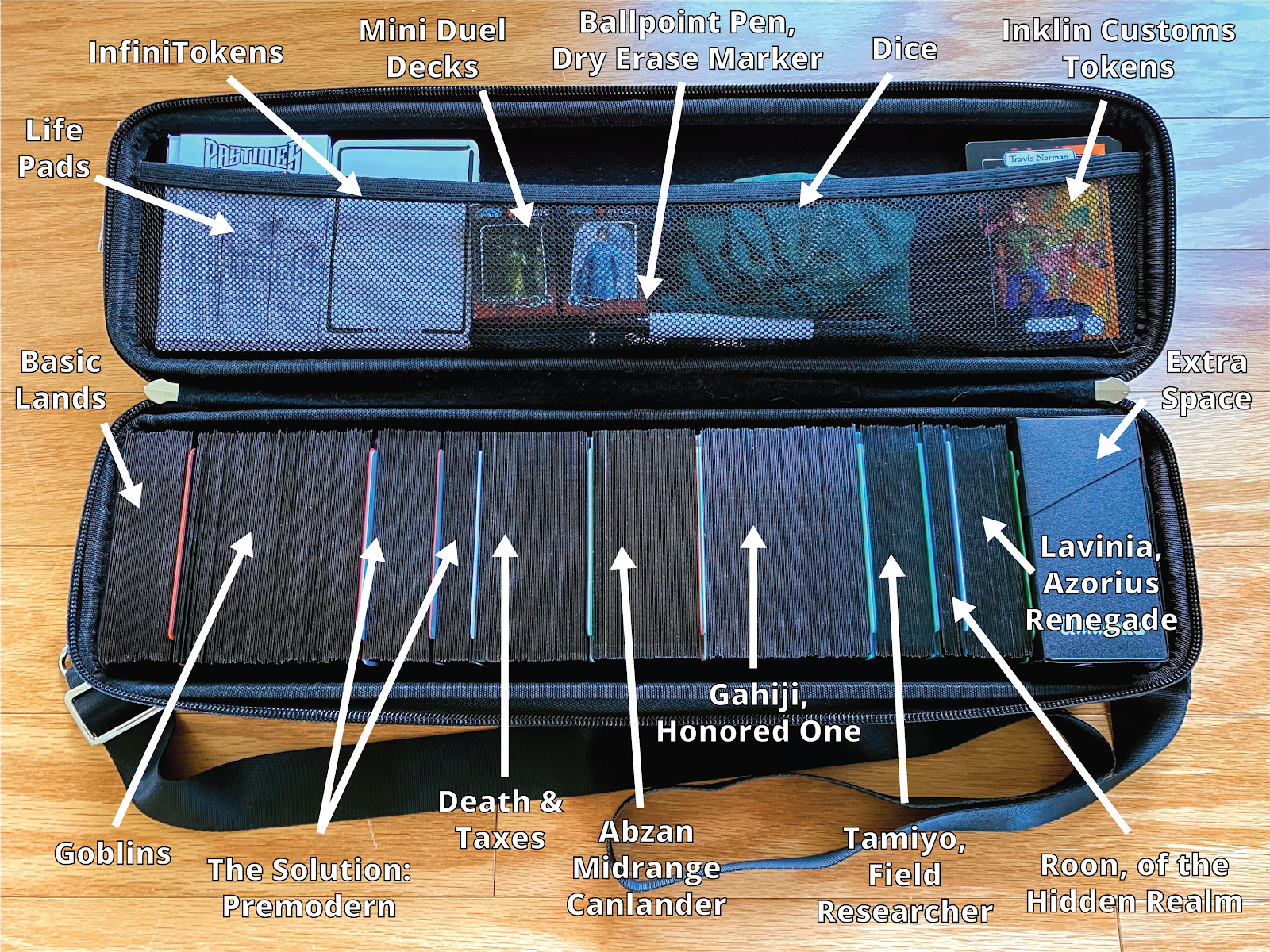
4. Decks must share a decent number of cards, but they should all feel different to play.
This is the backbone of the modular system. Each deck should be able to borrow from the others, so they can all contribute something to the group. As you can see from the above list, each deck shares some similar pieces with the others. While the Goblins decks share the least with the others, the space they take up is rather small. All three of those decks share a core of Goblin Piledriver, Goblin Matron, Goblin Warchief, and Goblin Ringleader. So when you eliminate duplicates, you get three different Goblin decks, in three different formats, for about 110 cards. Without the modular approach, you’d have 225 cards, occupying nearly double the storage space.
Commander decks are always the largest, but I didn’t want to be stuck with just one or two—so I had to get creative with how I found space for them. Using pieces of Gahiji, Honored One, and my Tamiyo, Field Researcher deck, I built Roon of the Hidden Realm. Roon is essentially a 40-card supplement to my Tamiyo Oathbreaker deck, which I can take off to easily swap between formats.
As for Lavinia, Azorius Renegade, it stands out from the others. Seeing that it’s a cEDH deck, it’s going to have more powerful things, like free counterspells and fast artifact mana. While I expect it will be my least-played of the bunch, I can always dip into the staples suite to beef up Gahiji or Roon. Since power level evaluations are all over the map, this can help find a middle ground with non-cEDH players who are underselling their decks a little.
Spreadsheet Mechanics
When building the case, I wasn’t sure of how many decks I’d actually be able to fit in it. So, I was willing to make various concessions to get the most bang for my buck. To keep everything organized, I used a spreadsheet from Google Sheets.
Most deckbuilding sites have a CSV upload option, allowing you to download your decklist in plain text. I followed that for all ten decks, and dropped them into a single spreadsheet. Before eliminating duplicates, I had 775 cards; too much for the Quiver to fit. I needed to start trimming edges.
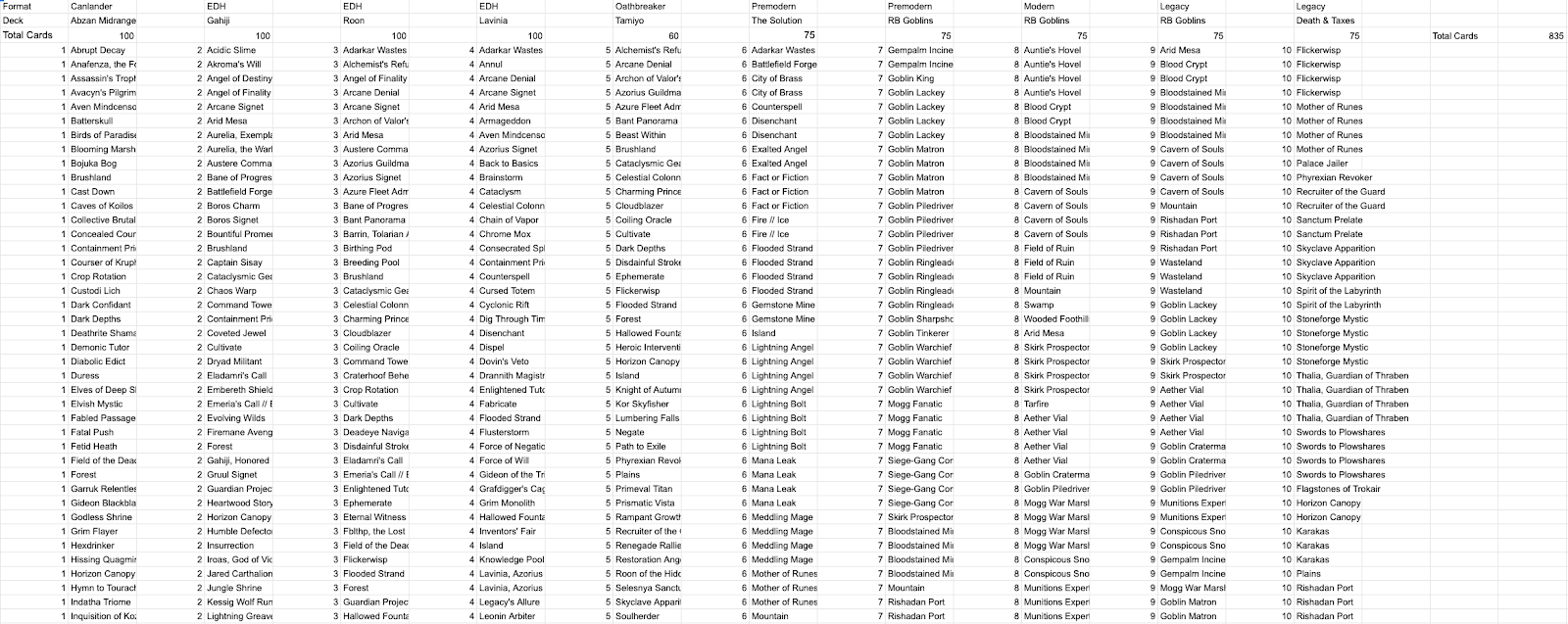
To do this, I gave each deck a value from 1-10. That allowed me to know which card was coming from what deck, after I sorted out all the card names. I put each decklist in one long column, then alphabetized it. The results came out like the following.
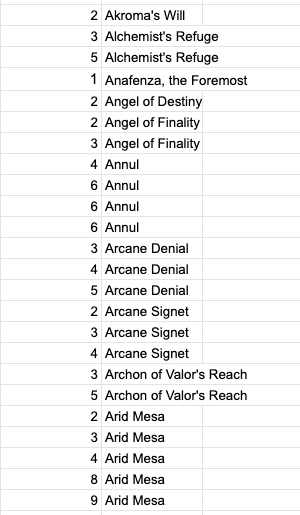
When we dive in deeper here, we can extrapolate the following. Cards like Anafenza, the Foremost and Arcane Signet are found as singletons, so I don’t need to pack more than one. Meanwhile, Annul needs three copies in one place, and one in another. Since I don’t expect to be running four Annuls in my Premodern sideboard, I packed only three. The temptation is high to round out with full playsets, but if you compound that over several different cards, you lose significant storage space. As for Arid Mesa, it’s an example of adding a single card to multiple decks, saving me space overall. Though I usually don’t like running off-color fetches in my Commander decks, I made an exception for this space-saving trick.
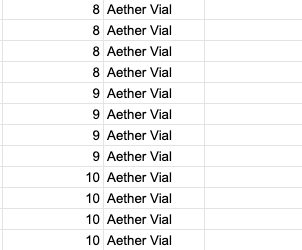
The sorted column had a lot of cleaning up to do, when it came to duplicates. When I came across a situation like Aether Vial, I deleted all of the extra playsets. This would allow me to chip away at that 775 number, to hit my sub-630 goal.
After getting rid of duplicates, I ended up with 495 total cards, not counting basic lands. As you can see, the column for my Tamiyo deck got completely swallowed up by Roon. It’s worth mentioning that you don’t have to get too granular on what card is listed where. This technique is just for sorting out your total card count. For instance, Mindbreak Trap can be played by both Legacy Goblins, as well as Death & Taxes, so it doesn’t really matter which column I sort them in here.
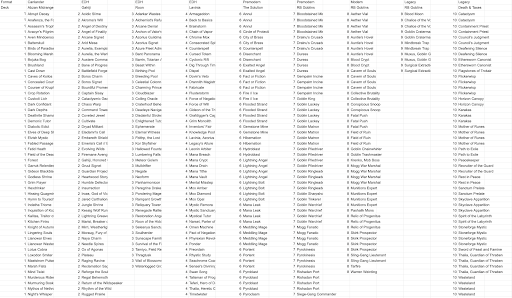
To avoid having basic lands crowd my numbers, I reduced them to single values while sorting. I already understood my basic land needs, so I did not include them in the sorting sheet here.
Other Considerations
At time of writing, I still haven’t decided on whether to have paper decklists inside the case. On one hand, it would help getting all the cards right for the singleton decks. On the other hand, they could get out of date quickly. I might find that I like running Recruiter of the Guard in Roon, so I don’t want to be locked into a paper decklist. For this, I think I’ll stick with online decklists that can be easily changed.
Some people use a system of colored dot stickers on their internal sleeves, which can help sort cards on the fly. Find all 100 cards of that particular color, and you’re good to go. While that works for social formats, I chose not to do it while I have Modern and Legacy decks in the pool. I don’t want to enter a Comp REL event and have a judge called because my Aether Vials have more stickers than my Flickerwisps.

Extra Goodies
While I love having the right paper tokens, carrying all of them can take up a ton of space. So, I’m bringing InfiniTokens along. They can be anything, from a 3/3 Beast to the spell I name with Meddling Mage. Also, in long Commander games, they give you a chance to doodle something fun while you wait for your turn.
The Quiver comes with card dividers, but they’re thick and bulky. In the interest of saving space, I sought skinnier options. Ultimate Guard makes colored card dividers, and you can get them in the five colors of Magic. I ended up using mine to signify which deck was where in the case, based on its prevailing colors.

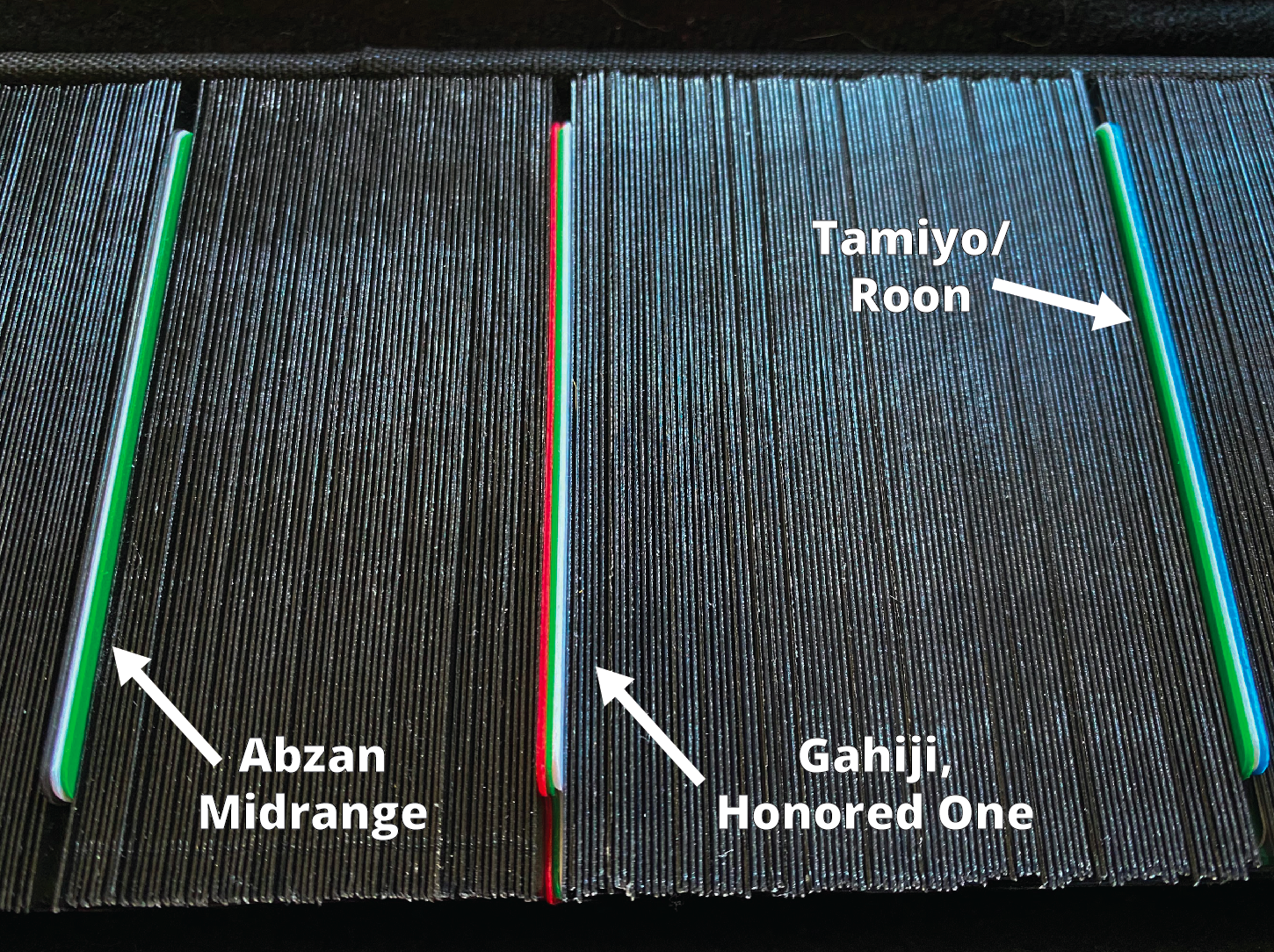
For keeping track of life, I’m using the small lifepads given out at big events. They’re not the most eco-friendly, but since a 5” Ultimate Guard life pad won’t fit inside the case, they’ll have to do. Written life pads are the most reliable for competitive events, so that standard takes precedent.
I’m a big fan of the mini duel decks put out by World’s Smallest, so I was able to slot a pair of them in the upper mesh cabinet. Sometimes, your friends need a palate cleanser from casting Brainstorm all day. Wizards of the Coast just launched an Ajani vs. Nicol Bolas set, so you can bet they’re going in there too.
Finally, you may notice the lack of a playmat in there. The main criticism I have for the Quiver is that it doesn’t easily fit a playmat, so I’ll have to go without that piece of gear. However, most large events have table cloths, so that’ll protect your sleeves better than a blank surface. On the plus side, not bringing a playmat means less setup and takedown for each match. And you might end up acquiring a new playmat or an extra from a friend anyway.
Moving Forward
It’s going to be some time before we have large in-person events again, but I’m excited for this new method. I’m nearly done with my first draft of the system, and I’m hoping to end up with a little space for cards that I buy from MagicFest vendors. After testing it out with friends, it feels pretty straightforward when it comes to finding cards that I need. If a card is split between two decks, I pick one that’s easier to remember where to look. For instance, I keep my Skyclave Apparitions in Death & Taxes, instead of my Commander decks. After a game night is over, I’ll sort out my pieces so that they’re easier to go through next time. I have to scramble a little quicker than others to change decks, but that’ll come with practice. If I can fit a low-profile deck box in there, I’m considering using it as my “deck of the day” space. That way, if I’m in a multi-round event with one deck, I can pull that one out easily for each match.
This process has also helped me pare down my collection. I used to own a Smothering Tithe for every deck that could run it, but it was a lot of money tied up in duplicate cards. When your decks share sleeves, you only need to own one copy. I wound up buylisting a lot of my extraneous cards, and it allowed me to finish building the two Legacy decks found in the case. While this technique might not be for everyone, I look forward to the ease of ownership and maintenance.
Play well, live simply.
Travis is a Virginia-based player and writer, who has been turning things sideways since Starter 1999. He primarily plays Commander, Pauper, and Legacy, and has a passion for introducing new players to the game. When he isn’t making people pay the Thalia tax, he can be found mountain biking or playing the guitar. You can follow his exploits here on Twitter and Instagram.

